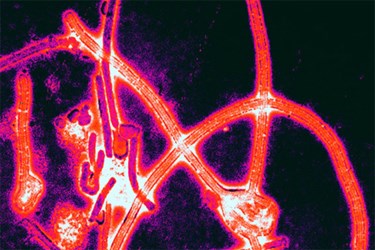Ebola Patient Treated With Investigational Blood Filtration Device
By Chuck Seegert, Ph.D.

For the first time, Ebola is being treated using the Aethlon Hemopurifier (AHP) system. The method is a novel approach to treating viruses that filters them from the blood along with certain protein-based pathogens.
The West African Ebola outbreak continues to extend its reach with cases now being diagnosed in the United States and Europe. Currently, there is no known treatment for the virus, which is lethal in a significant majority of cases. While treatments for the disease are being developed with some urgency, alternatives to conventional therapeutics are receiving marked interest as well.
The AHP is one such therapeutic method that is being investigated at Frankfurt University Hospital, according to a press release from Aethlon. The patient is a Ugandan doctor who works for the World Health Organization. While ministering the ill in Sierra Leone, the doctor contracted the disease.
"We thank the physicians in Frankfurt for allowing us the opportunity to treat this advanced-stage patient," stated Aethlon founder and CEO Jim Joyce in the press release. "Details related to the patient's response to therapy will be disclosed once hospital officials deem it appropriate to report an update on the condition of this individual."
The AHP is currently being prepared for clinical trials in the U.S. under an investigational device exemption from the FDA. Initial tests started in India where it was used to treat human immunodeficiency virus (HIV) and Hepatitis C virus (HCV). Successful in vitro validation studies of the device’s effectiveness against Ebola Zaire were conducted by the Centers for Disease Control (CDC) and the United States Army Medical Research Institute for Infectious Diseases (USAMRIID).
The AHP is said to have the capability to capture a broad spectrum of viral pathogens. In tests with HIV and HCV, it has been shown to reduce viral loads by up to 50 percent during a 4 hour treatment, according data published on the company website.
The technology passes blood through its porous membrane media, and viral particles and fragments of these particles are captured by specific biomarkers attached to the media, according to a patent application filed by the company. These biomarkers may be lectins or other molecules that can be tailored to a specific disease.
Filtration of blood as a way of eliminating or reducing circulating pathogens is the focus on many research groups that have developed a number of novel approaches. One such device has been termed the “biospleen,” because it filters pathogens like the organ it was named after, according to a recent article on Med Device Online. Another project has received significant grant money from the National Science Foundation for a microfluidic approach.
Image Credit: “Ebola Virus Particles.” Thomas W. Geisbert, Boston University School of Medicine. 2008 CC BY 2.5: http://creativecommons.org/licenses/by/2.5/
